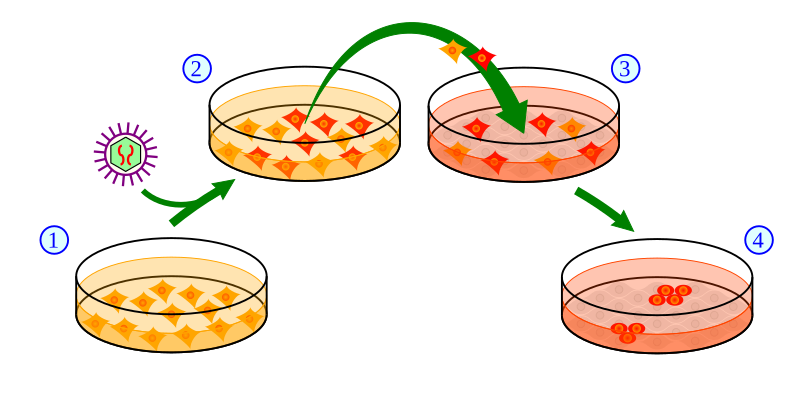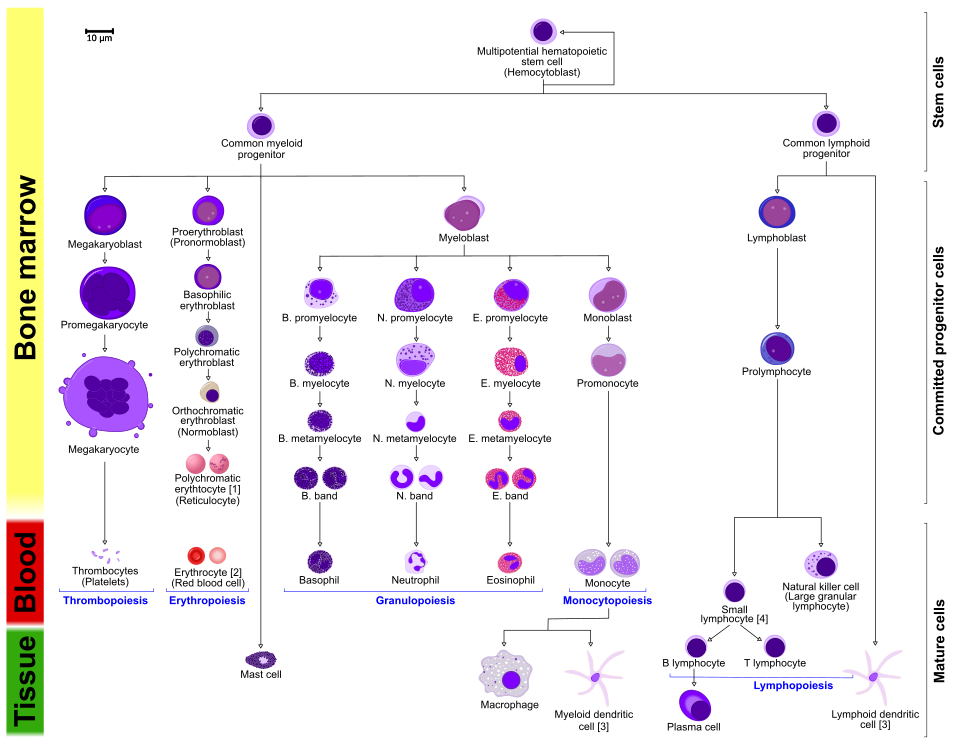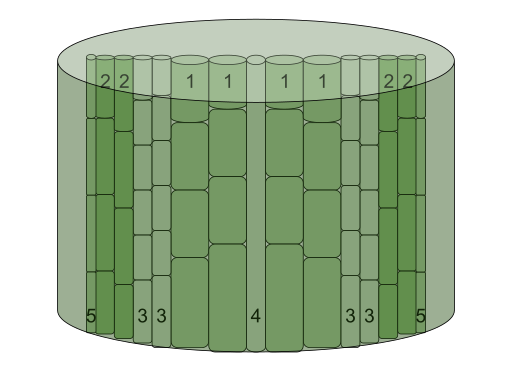OCR Specification focus:
‘Explain stem cell features; blood, xylem and phloem differentiation; outline research and medical uses.’
Stem cells are undifferentiated cells capable of dividing and specialising into diverse cell types. Their unique properties underpin growth, repair, and advanced biomedical applications.
Stem Cell Characteristics
Definition and Key Features
Stem cells are unspecialised cells with the potential to divide repeatedly and differentiate into specialised cell types. They are vital for development, maintenance, and tissue repair.
Stem cell: An undifferentiated cell capable of self-renewal through mitosis and of differentiation into specialised cell types.
There are two key characteristics:
Potency – the ability to differentiate into various cell types.
Self-renewal – the capacity to divide many times without losing function.
Types of Potency
Stem cells vary in potency according to their developmental potential:
Totipotent – can form all cell types, including embryonic and extra-embryonic tissues (e.g. zygote, early embryo).
Pluripotent – can form any body cell but not extra-embryonic tissues (e.g. embryonic stem cells).
Multipotent – can form a limited range of cell types within one tissue (e.g. adult stem cells in bone marrow).
Unipotent – can differentiate into one specific cell type only (e.g. muscle stem cells forming muscle fibres).
Stem cell potency decreases as an organism develops from zygote to adult.
Sources of Stem Cells
Embryonic Stem Cells
Derived from the inner cell mass of a blastocyst, these cells are pluripotent and can form any cell type in the body. They are key tools in research due to their flexibility but raise ethical concerns surrounding embryo use.
Adult (Somatic) Stem Cells
Found in differentiated tissues such as bone marrow, skin, and the gut, these are multipotent. They primarily maintain and repair the tissues where they reside.
Induced Pluripotent Stem Cells (iPSCs)
Adult cells that have been genetically reprogrammed to behave like embryonic stem cells.

Schematic of iPSC induction, showing somatic cell isolation, introduction of reprogramming factors, and emergence of ES-like colonies. This clarifies why iPSCs provide an ethical alternative and a powerful tool in regenerative medicine. Note: the inclusion of viral vectors and feeder cells is additional context not required by OCR but helps explain the biomedical workflow. Source.
iPSCs provide an ethical alternative for research and therapy as they do not involve embryos.
Differentiation and Specialisation
Definition and Process
Differentiation is the process by which a stem cell develops into a more specialised cell type with distinct functions and structures.
Differentiation: The process through which unspecialised stem cells become specialised cells by activating specific genes and producing distinct proteins.
This process involves:
Gene expression changes, turning on certain genes while silencing others.
Protein synthesis variations that lead to specialised cell structures.
Signal molecule interactions guiding developmental pathways.
Examples of Differentiation
Blood Cells
Haematopoietic stem cells (HSCs) in bone marrow are multipotent and give rise to:

Labeled schematic of human haematopoiesis, tracing differentiation from a multipotent HSC to major blood cell lineages. This visual reinforces terminology used in the notes and illustrates how growth factors and cytokines channel lineage choice. The diagram is clean, vector-based, and suitable for close reading. Source.
Erythrocytes (red blood cells) – transport oxygen via haemoglobin.
Leucocytes (white blood cells) – defend against pathogens.
Platelets – fragments involved in blood clotting.
Differentiation in blood stem cells is regulated by growth factors and cytokines.
Plant Stem Cells: Xylem and Phloem
In plants, meristematic tissue contains plant stem cells located in:
Apical meristems (root and shoot tips) – responsible for primary growth.
Vascular cambium – produces secondary xylem and phloem, increasing stem thickness.

Simplified cross-section of a stem showing xylem, phloem, and the vascular cambium that generates them. Labels include companion cells associated with phloem sieve tubes, aligning with the notes’ description of phloem differentiation. This diagram focuses on structure; it avoids extra processes beyond what the syllabus requires. Source.
Xylem differentiation involves:
Deposition of lignin in cell walls for strength and waterproofing.
Programmed cell death, creating hollow tubes for water transport.
Phloem differentiation involves:
Formation of sieve tube elements for translocation of sugars.
Association with companion cells, which maintain sieve elements via plasmodesmata.
Biomedical and Research Applications
Regenerative Medicine
Stem cells can replace damaged or diseased tissues:
Bone marrow transplants treat leukaemia and lymphoma by replacing defective blood cells.
Stem cell therapy for Parkinson’s disease and diabetes aims to restore lost or damaged cells.
Skin grafts and cartilage repair utilise stem cells for tissue regeneration.
Drug Testing and Development
Stem cells are used to:
Test drug toxicity and effectiveness on human-like tissues before clinical trials.
Model diseases in vitro, enabling safer and faster discovery of new therapies.
Research into Developmental Biology
Stem cell studies reveal insights into:
Embryonic development and cell signalling pathways.
Gene regulation during differentiation and tissue formation.
Epigenetic modifications, such as DNA methylation, affecting gene expression.
Ethical and Practical Considerations
Ethical Issues
Embryonic stem cell research raises debate because:
It involves destruction of human embryos.
Questions arise over the moral status of embryos and consent.
Religious and cultural perspectives influence acceptance.
Alternatives and Regulation
The development of iPSCs reduces ethical controversy.
Research is regulated to ensure responsible use, informed consent, and transparency.
Bodies like the Human Fertilisation and Embryology Authority (HFEA) oversee UK research compliance.
Practical Challenges
Immune rejection may occur when transplanted cells are recognised as foreign.
Tumour formation risk exists due to uncontrolled stem cell proliferation.
Ensuring differentiation precision remains a technical hurdle in therapy development.
The Future of Stem Cell Research
Ongoing innovations aim to improve:
Tissue engineering using stem cells and scaffolds to build replacement organs.
Gene editing (e.g. CRISPR-Cas9) to correct genetic defects before transplantation.
Personalised medicine, where patient-derived stem cells generate immune-compatible tissues.
FAQ
Stem cell differentiation is initiated by specific chemical and physical cues in the surrounding environment, known as the stem cell niche.
These cues include:
Growth factors and cytokines, which activate intracellular signalling pathways.
Contact with neighbouring cells, influencing gene expression through surface receptors.
Extracellular matrix composition, providing structural and biochemical signals.
Collectively, these signals alter gene activity, turning on or off sets of genes that guide the cell toward a specific lineage.
To keep stem cells undifferentiated, researchers recreate the conditions of the stem cell niche.
This involves:
Using specialised growth media containing nutrients and inhibitory factors such as leukaemia inhibitory factor (LIF).
Culturing cells on feeder layers or matrices that mimic natural tissues.
Carefully controlling temperature, pH, and oxygen concentration.
If these conditions are altered, stem cells can spontaneously differentiate, which makes maintaining them challenging.
While iPSCs reduce ethical issues, they present biological and safety challenges.
Key risks include:
Genetic instability from the reprogramming process, potentially leading to mutations.
Tumour formation (teratomas) if undifferentiated cells are transplanted.
Incomplete differentiation, causing mixed or malfunctioning tissue types.
Immune response, despite being derived from the patient’s own cells, due to reprogramming-induced antigen changes.
Researchers are developing improved methods for reprogramming and screening iPSCs before clinical use.
The vascular cambium is a lateral meristem responsible for producing secondary xylem and phloem, contributing to the thickening of stems and roots.
Its significance includes:
Maintaining a continuous supply of new conductive tissue, replacing older, non-functional cells.
Allowing plants to transport water and nutrients efficiently as they grow larger.
Enabling repair when vascular tissue is damaged, ensuring sustained transport and survival.
This regenerative ability is one reason why many plants can live and grow for decades or even centuries.
Embryonic stem cells are obtained from early-stage embryos, raising ethical concerns because the process destroys potential human life.
In contrast, adult stem cells are harvested from consenting donors without harm, making them ethically acceptable.
However, embryonic stem cells offer greater potency and flexibility, while adult stem cells are more limited in the range of cells they can form.
As a result, modern research increasingly focuses on induced pluripotent stem cells (iPSCs), which combine scientific utility with fewer ethical dilemmas.
Practice Questions
Question 1 (2 marks)
State two characteristics of stem cells that make them important in growth and repair in multicellular organisms.
Mark scheme:
One mark for each correct characteristic (maximum 2 marks):
Ability to divide repeatedly / self-renew. (1)
Ability to differentiate into specialised cell types. (1)
Question 2 (5 marks)
Describe how stem cells are involved in the differentiation of blood cells and explain one potential biomedical use of stem cells in medicine.
Mark scheme:
Description of differentiation (maximum 3 marks):
Haematopoietic stem cells (HSCs) found in bone marrow are multipotent. (1)
HSCs divide by mitosis to form new stem cells and precursor cells. (1)
Precursor cells differentiate into specific blood cell types such as erythrocytes, leucocytes, and platelets. (1)
Explanation of biomedical use (maximum 2 marks):
Stem cells can replace damaged or diseased cells / tissues. (1)
Example: bone marrow transplant for leukaemia or use of stem cells to regenerate tissues such as cartilage or neurons. (1)

